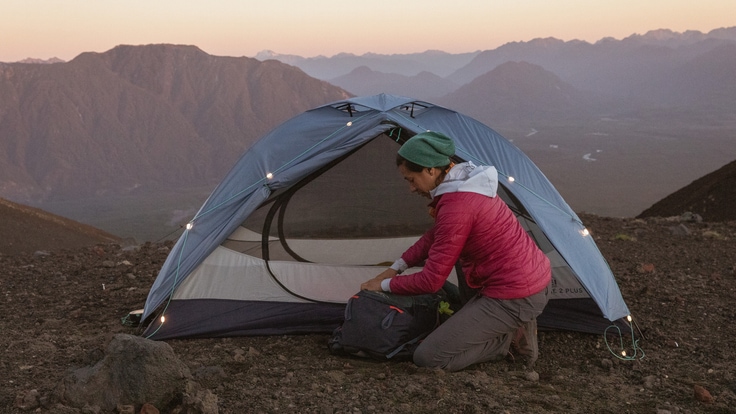A tent footprint is a sheet of fabric, often made of polyester, nylon and/or polyurethane. It’s placed between a tent and the ground when camping or backpacking to protect the tent floor from abrasive elements, like sharp twigs, jagged rocks or gritty surfaces, explains Elizabeth Nguyen, a camping and climbing veteran and senior sales specialist at the REI store in Atlanta, Georgia.
Tents are made to withstand the elements, but even the sturdiest shelters puncture, snag and develop holes over time. While some wear and tear is normal, your tent can last far longer when paired with a tent footprint, which helps protect your shelter from the ground. In this article, we cover what a tent footprint is, how to use one and what to look for when buying.
While a tent footprint isn’t always necessary (for instance, if you’re camping or backpacking on soft sand or grassy areas), investing in one can keep your shelter in use for longer. Tent footprints typically cost between $40 and $200, depending on size, durability and other factors; on the other hand, having to buy a new tent due to damage costs considerably more. You can also shop used footprints (or trade in your own) through REI Re/Supply.
“Because I use a tent footprint, I’ve never had to replace my tent,” Nguyen says. “I’ve had it for about 15 years now.”
In addition to protecting your tent, your footprint can double as a ground cover for picnics and outdoor concerts, says Carlos Rodriguez, an REI department manager in Wichita, Kansas. It can even work as a rain cover in a pinch.
How Does a Tent Footprint Compare to a Tarp?
Some people opt for tarps, rather than footprints, when backpacking or camping: These durable fabric sheets can similarly provide a layer between the ground and your tent. However, unlike tent footprints, tarps aren’t specific to your tent’s dimensions. Tent footprints are designed to match the shape and size of your shelter’s floor, which can help keep your space dry and clean. A tarp that extends beyond the length of your tent could collect condensation that pools into your living space.
Additionally, footprints are often lighter and less bulky compared to tarps of similar dimensions, says Nguyen. Tent footprints sold at REI can weigh anywhere from 7 ounces to 8 pounds, depending on the size and material.
How to Use a Tent Footprint
Follow Leave No Trace principles when choosing a suitable spot to set up camp and, if possible, pitch your tent away from high-friction surfaces and abrasive materials like twigs or rocks. Rodriguez recommends laying down your tent footprint first, then spreading your tent atop the footprint, lining up the eyelets “so when you stick it out with your poles, they’re going to connect right into the same pole fasteners.”
How to Choose a Tent Footprint
There are several main features to consider when choosing your tent footprint: durability, material and size.
You’ll also want to think about how often you plan to camp and the terrain you’re most likely to encounter. For instance, you may care less about durability if you camp three times a year at a soft, grassy campground than if you’re setting up camp every summer weekend on gritty rock.
Durability
When choosing a tent footprint, evaluate how well it’ll stand up to use. The main way to gauge a tent footprint’s ruggedness is to check its denier. Denier is a unit of measurement that accounts for the weight and thickness of threads used in a fabric. The higher the denier, the thicker and stronger the tent footprint. The denier rating for a tent footprint can range from 60 denier to 300 denier; Nguyen recommends 250 denier or higher if you’re prioritizing durability. Higher-denier fabrics also tend to be heavier, while lower denier numbers signal lightweight, less durable fabrics.
Material
Tent footprints are constructed from different fabrics. Look for footprints made from durable, waterproof materials like polyurethane, nylon or polyester. These materials help extend your tent’s life by providing a barrier against sharp objects, moisture and abrasive surfaces.
Size
Nguyen says the footprint should be slightly smaller than the tent to prevent water from pooling between the tent and the footprint. A well-fitted footprint will keep your tent’s base dry and clean, ensuring a more comfortable camping experience.
Some tents come with a footprint designed for that model, which ensures a proper fit. Other times, a tent's matching footprint can be purchased separately. If a footprint isn’t available for your specific shelter, you can find universal footprints that can be cut or folded to fit your tent’s dimensions.
Do You Need a Footprint?
Ultimately, deciding whether or not you need a tent footprint will depend on where and how often you plan to camp, as well as personal preference. If you plan to camp on abrasive surfaces, take frequent trips or just want to extend the longevity of your tent, it's smart to invest in a footprint to protect your shelter. If you camp infrequently and on soft, grassy surfaces, a tent footprint may not matter as much.
Regardless of what you decide, it’s essential to consider the activity, conditions and number of people who will be using it (if you plan to use it as a standalone mat for picnics and other activities). Whether you’re camping in the backcountry or enjoying a movie at the park, the right tent footprint can help you enjoy your favorite outdoor activity for years to come.


